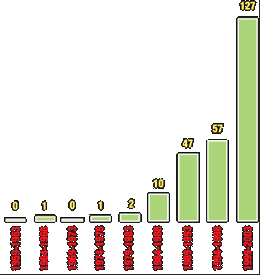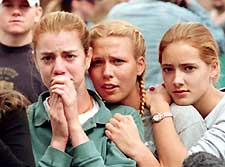School-Related Deaths Surge with Drug’s Use
|
PRESCRIPTION FOR DEATH School-related deaths such as Shaun Ouillette’s were rare 20 years ago. In recent years, coincident with escalating use of psychiatric drugs known to increase acts of hostility and aggression, such senseless violence has become an ongoing national tragedy. “It’s certainly not just Ritalin,” said Dr. Fred Baughman, pediatric neurologist, noting that in the United Kingdom, all but one of the SSRI* antidepressants were recently banned for anyone under the age of 18 due to their dangers. “Increasingly,” Baughman said, “it’s becoming apparent: it’s not just the amphetamines. The SSRIs and all psychiatric drugs may lead to a kind of a disintegration of self-control, and to violence or aggression toward self and others.” * Selective serotonin reuptake inhibitors — a class of antidepressants. |
||||||||
|
|
|||||||
|
|
|||||||
A quintessential truth was unearthed about the educational experience children encounter today: psychotropic drug makers, parasitic on the school system, have created a lucrative market for their own enrichment by “pathologizing” childhood behavior as mental disorders, with pseudomedical labels obediently supplied by the very psychiatrists who prosper from this corrupt arrangement.
School violence fatalities, virtually unheard of prior to the use of psychiatric drugs in schools, began only after introduction of those substances in the 1960s and 1970s. When and how were they introduced?
In 1963, a federal law provided for the largest subsidization of the psychiatric industry in America up to that time.2 Coincident with that intrusion into American schools, SAT scores plunged — a nosedive that continued for decades and has never recovered, despite a move by test officials in 1995 to “recenter” results by arbitrarily pushing scores higher.3
Simultaneously, this psychiatric presence facilitated the proliferation of mind-altering drugs in the nation’s schools. From 1973’s roughly 200,000 schoolchildren on psychotropics, usage has jumped 45-fold to today’s estimated 9 million.
All aberrant behavior was deemed “incurable” and was conveniently matched by a chemical proclaimed suitable for “treating” it. Thus, according to Bruce Wiseman, author and president of the U.S. Citizens Commission on Human Rights, “teachers were given a double-barreled ‘remedy’ for children who were challenges in the classroom: the psychiatrist’s ‘disorder’ and the pharmacist’s elixir.”
This “solution” became omnipresent in the 1980s and 1990s, when psychiatric/pharmaceutical front groups popped up to promote both disorder and treatment. By 2003, according to Wiseman, this ballooned into a $30-billion-per-year industry, with a web of financial incentives for school districts, school psychologists and psychiatrists to study, diagnose and treat educational “disorders” which, by science, do not exist.
The result? For the psycho-pharmaceutical industry: megaprofits. For schools, teachers, parents and children: insecurity, crime, mayhem and murder.
While school-related deaths such as Shaun Ouillette’s were rare 20 years ago, such killings surged in the 1990s — directly coincident with escalating use of psychiatric drugs, with their known side effects of increased acts of hostility and aggression.
Methylphenidate Connected with Psychotic Episodes and Violence
|
SCHOOL VIOLENCE FATALITIES
In 5-year increments School violence fatalities occurred after introduction of psychiatric drugs in schools in the 1960s and 1970s — exploding into a national problem as usage expanded from the late 1980s to the present. |
|

|
 STUDENTS AT COLUMBINE HIGH SCHOOL wait to hear the fate of their schoolmates after the shooting rampage by fellow students Eric Harris and Dylan Klebold. |
Of note, in 1995, the Drug Enforcement Administration said methylphenidate could be addictive and that its use had been connected with “psychotic episodes, violent behavior and bizarre mannerisms.”4
A 2001 study by Nora Volkow, M.D., now the director of the National Institute on Drug Abuse, found that methylphenidate had a more potent effect upon the brain than did cocaine.5
“Researchers were shocked by this finding,” as reported by The Observer. “A normal dose [of methylphenidate] administered to children blocked 70 percent of the dopamine transporters. ‘The data clearly show the notion that [methylphenidate] is a weak stimulant is completely incorrect,’ said Volkow. Cocaine is known to block around 50 percent of these transporters, leaving a surfeit of dopamine in the system, which is responsible for the hit addicts crave. But now it is known that [methylphenidate] blocks 20 percent more of these auto-receptors.”6
764,000 violent crimes were reported in American schools in 2001 — the most recent year for which official statistics are available — a sharp rise over the nearly 700,000 reported in 2000.7
The 2003–2004 public school year began with an explosion of shootings, beatings and stabbings that produced 28 deaths by December 23, 2003 — “more than in either of the past two entire school years.”8
Street Sales Soar
Today, prescriptions for methylphenidate are easy to get — so easy that illegal use of the drug for a fast high has become rampant.
With street sales of this “speed”-type substance first exposed by Freedom as a national problem in 1988,9 a 2003 report on “Good Morning, America” confirmed the ongoing story: “A growing number of young people are snorting Ritalin to lose weight, study for exams and in some cases, just to get high, according to some drug experts.”
The report described a student at a Minneapolis drug treatment facility who began taking methylphenidate after being diagnosed with ADHD as a sixth-grader. He later sold the drug to other students, reporting that those most interested were youngsters who were trying not to do “real drugs” — a trap since, as mentioned, methylphenidate is similar to amphetamine and cocaine, and has been shown to have a more powerful effect than the latter.
Drug abuse can become a longtime problem for children given stimulant drugs such as methylphenidate. A 26-year study by Nadine Lambert, Ph.D., director of the School Psychology Program at the University of California, Berkeley’s Graduate School of Education, found that children treated with methylphenidate or other stimulant drugs “are more likely to abuse cocaine and other stimulants as adults.”10
They encounter other problems as adults, with one study showing that children who have taken psychiatric stimulants for ADHD being 46 percent more likely to commit a felony.11 And those who have received such a diagnosis may be ineligible to serve in the armed forces. (See “The Scandal of ‘Kiddie Coke,’”.) Indeed, in 1998, the U.S. military “officially discharged more than 3,100 recruits with psychiatric histories, either in boot camp or within the first six months of enlistment.”12




